
views
X
Research source
Managing Your Practice Time

Create a consistent practice schedule. The amount of time you play and the number of practice sessions you build into a week depends in part on your age, attention span, and seriousness with learning to play the instrument. However, the important thing is to be consistent with your practice times so you develop a habit of playing the piano. For example, if you have weekly lessons with a teacher, you may want to practice for an hour 6 days a week, then schedule a 30-minute practice session before your lesson each week. On the other hand, if you're just learning piano on your own for fun, you might decide to practice 30 minutes a day for 3 days a week. Younger children typically learn more with shorter practice times. If you have issues with focus or attention deficit, you may find you get more out of shorter practice times per day as well. If you ultimately want to practice more, simply schedule several shorter sessions throughout the day. For example, you might have one 15-minute session in the morning, one 15-minute session in the afternoon or early evening, and then another 15-minute session at night.Tip: Choose the time of day when your focus is best. If you're a morning person, you might get more out of studying first thing in the morning. However, if you're more of a night owl, you might find it harder to focus at an early hour.
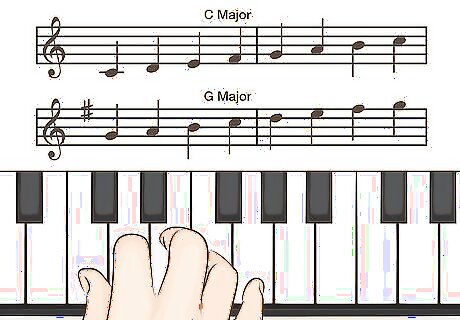
Start each practice session with a warm-up piece. Basic scales are a good way to warm up for your piano lesson. You might also look for etudes, which are classical pieces written for practice (the word "étude" is French for "study"). Many of these short pieces are actually fun to play, and are designed to help warm up your fingers and get you ready to play more complex pieces. If you've been playing for a while, you might also use an easier song that you've already mastered to warm up. Starting your practice off by playing something familiar that you're already good at will give you a nice confidence boost going into your practice.

Break up pieces into short-term goals. If you're working on a shorter, simpler song, you may be able to master it in one session. However, once you progress to longer, more complicated pieces, you may find that you struggle if you try to learn them all at once. Start with manageable bites of the piece, then put those pieces together. Making measurable progress will increase your confidence and help you learn more efficiently. For example, if a piece is 8 pages of sheet music, you might set a goal to learn one page each practice session. When you've learned the last page, you should be able to play the entire song from beginning to end. If you run into a particularly troublesome passage that you struggle with, you might need to break the piece down even further. Take it a measure at a time, then play the whole line, then add the next line, and so on.
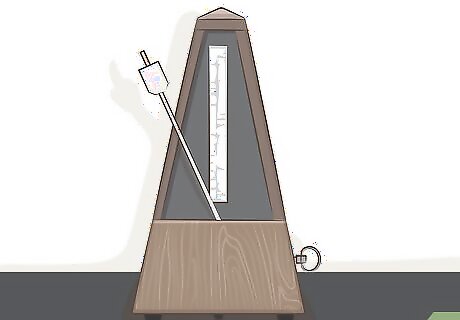
Use a metronome to control your tempo. When you encounter a new song, start by playing it much slower than its natural speed. This will enable you to get the notes right the first time through. Once you've played it through slowly a few times with no errors, gradually increase the tempo until you're playing the song at its natural speed. This practice method helps you avoid those recurring errors that become engrained after you try to play a song too many times at a faster speed. If you find that no matter how many times you play a song, you always seem to miss a particular note, it may be that you've been practicing it too fast. Slow it down and focus on that tricky passage until you've corrected the muscle memory that causes that finger to shoot for the wrong note.

Eliminate distractions during practice time. Choose a relatively quiet place to practice where you're not likely to be interrupted and silence all notifications on your electronic devices so you won't be tempted to check them. If you need a break, take 5 minutes to stand up and stretch or walk around the room, then continue with your practice. If you share your home with others, let them know when you're going to be practicing each day and make sure they understand that you're not to be disturbed during that time. If there's a door you can close to shut yourself off from the rest of the household, do so — that will allow everyone else to carry on their normal activities without worrying that they're distracting you.
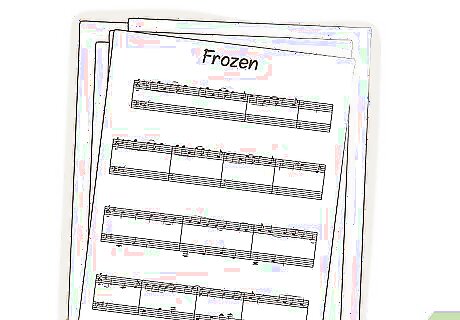
Choose songs you enjoy playing. Focusing on songs you love will help you stay motivated to practice. If you have a piano teacher, they no doubt assign specific pieces for you to learn. However, that doesn't mean you can't add a piece or two you want to learn to your practice time. Almost any popular song you can think of has a piano adaptation, even if there's no piano in the original song. Many of these songs have multiple versions, so you can learn the song whether you're at a beginning, intermediate, or advanced level. For example, if you like the music from the movie "Frozen," you can buy sheet music and learn to play it. If you're playing a song you love, you may be tempted to run over your practice time so you can keep practicing it. However, it's better if you avoid doing this. If you maintain discipline and stop at your scheduled time, you'll retain that excitement to get back to the piece at the next practice session. Try songs of different genres and styles to help find your favorite style of piano play. For example, if you are studying classical piano, you might want to try some jazz or pop pieces. EXPERT TIP Amy Nicole Levine Amy Nicole Levine Pianist, Music Teacher, and Songwriter Amy Nicole Levine is a Pianist, Music Teacher, and Songwriter, based in Oakland, CA. She performs in a wide variety of genres ranging from Jazz, Classical, Funk, R&B, Gospel, Rock, Reggae, Latin, Chorale, and others. Amy teaches private piano lessons to both adults and children at her studio in Oakland. Amy plays with multiple music groups throughout the Bay Area. She earned her Bachelor of Arts in Sociology from San Francisco State University. Amy Nicole Levine Amy Nicole Levine Pianist, Music Teacher, and Songwriter Exploring different teachers is key when looking for the best piano instructor. Word of mouth is great, but online reviews on sites like Yelp also help. It's important to try some trial lessons with various teachers to ensure a good match. The student-teacher connection matters, regardless of the teacher's skills. Assessing that dynamic is vital for productive piano lessons.
Building Your Sight-Reading Skills

Learn the musical alphabet and the staff. Music is no less a language than the language you speak. If you want to become fluent in the language of music, start with the musical alphabet and practice it until you know it as well as you know the alphabet of your spoken language. Simple flashcards are good to drill yourself on each of the notes. You may be able to buy them online, or you can make them pretty easily yourself with some construction paper and markers. Make sure you understand all the basic notations on the musical staff as well. Flashcards can also help you to memorize these.

Memorize common key signatures. Key signatures are essentially shortcuts that tell you what notes to play. If you recognize a key signature, you'll automatically know what sharps and flats are coming your way. You can drill yourself on key signatures using flashcards, the same way as you learned the musical alphabet. To connect the key signature to the sound, try playing or humming the scale in that key. Practicing scales in each key will also help you develop muscle memory, so that when you see that key signature, your fingers will automatically know which notes to play.

Try transcribing a song as you listen to it. Transcribing a song by ear not only helps you become more fluent in the language of music but also helps you train your ear. Start with a relatively slow song, then progress to faster songs. At first, choose songs where the piano is the only instrument being played. Play a few bars, then pause the song and attempt to write what you heard on a piece of blank staff paper. When you've transcribed a whole song, sit down at your piano with your sheet music and play what you wrote. Highlight notes or passages that you got wrong, then go back and listen again. Keep going until you get it right.

Identify guide notes to help you quickly understand other notes. Guide notes, such as Middle C, are notes that you can immediately pick out from any piece of music. If you see your guide notes while glancing at a sheet of music, they can help you identify the other notes based on those notes' relation to the guide notes. Having a few guide notes can be extremely helpful if you have a complex piece of music that spans several octaves. Looking for guide notes also allows you to get a sense of the song before playing it, even if you don't have particularly strong sight-reading skills. You've already got those markers laid out, and know that the other notes will rise or fall around those markers.

Familiarize yourself with different time signatures. The song's time signature is notated at the beginning and then again whenever it changes. In simple classical songs, the time signature typically won't change. However, you'll encounter this more frequently with jazz and pop music. Memorize the rhythm of the different time signatures, so if you see something in 4/4 or 2/4 time, you automatically know how the notes flow. Practice tapping out the rhythm on a tabletop or on the side of your piano.Tip: Practice songs you already know in different time signatures. These exercises can help you learn something about musical arrangements and composition.

Choose pieces you're not familiar with to test your skills. If you've played a song a dozen times, you may think you're sight-reading when, in reality, you're relying at least in part on familiarity and muscle memory. Look for a song you've never seen or heard before and read the sheet music. Look over the music before you sit down to play. Hum it softly as you read, or imagine it being played in your head. Then play it on the piano and see how close your reading was to the actual sound. Keep in mind it can take some time to get to the point where you can read a piece of sheet music as you would read a book. Take your time and practice a little each day, as you did when you were learning to read language.Tip: Compare this to learning to read a language. You didn't learn how to read books by reading the same books over and over, but by reading new books. Likewise, you can only master sight-reading by reading different music that you've never seen before.
Developing Your Technique
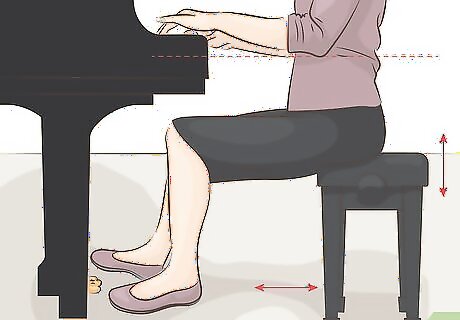
Check the position of your piano bench. Sitting either too close or too far away from the piano can ruin your technique and make it much more difficult to play. Likewise, poor posture can limit your movement and limit your ability to play harder pieces without discomfort. Sit on the edge of the piano bench and move it either forward or backward until your elbows are slightly in front of your shoulders when your hands are on the keys. If you have a curved spine or related disability, you may not be able to achieve the same positioning as an able-bodied person without pain. Adapt the technique as best as you can and focus on minimizing discomfort while maximizing your ability to play the instrument.Tip: Keep your body relaxed. Tension will inhibit your playing ability. As you play, check in with your body regularly to identify places where you are tense and loosen the muscles there. Make sure your wrists extend straight from your arms, rather than bending. Bending your wrists can cause muscle tension and strain that could eventually lead to overuse injuries.
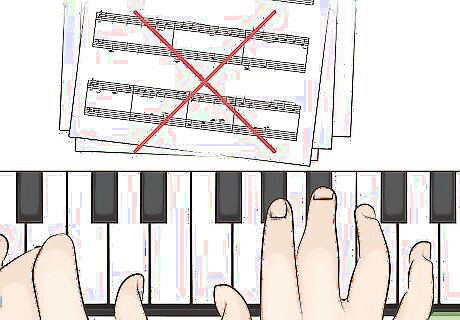
Memorize pieces early so you can focus on technique. If you memorize a piano piece at the same time you're learning it, you won't have to worry about reading the sheet music or thinking about the notes. Instead, you can focus on your body position and the way you play the notes. After you've memorized a piece, you can start to really feel the music. Even without the sheet music, you'll develop the intuitive ability to know when to pedal, when to play loudly or softly, and how to emphasize particular phrases in the music. You can also work on your tempo and rhythm more easily when you're not having to think about which notes to play.

Identify your technical weaknesses. Even the most experienced professional piano players have weaknesses. Instead of trying to work around them, find ways to challenge them and improve those areas until they are no longer weaknesses that limit you. For example, if your left hand is weaker or slower compared to your right, do strengthening and dexterity exercises that focus on your left hand. Bring your left hand up to the same level as your right and then you can continue strengthening both hands. If particular movements give you the most trouble, practice them over and over until the movement becomes second nature. Choose pieces that challenge your weaknesses in particular and encourage you to step up, rather than avoiding pieces that rely heavily on the skills you need to work on. While you may find it difficult at first, these pieces will help you improve your playing skills.

Work on your hand shape while away from the piano. Many beginners play the piano with flat fingers, which can hinder your ability to play more complex pieces later on. Once you've developed this habit, it can be hard to get rid of. However, if you practice curling your fingers on a regular basis when you aren't at the piano, your fingers will learn to fall into this position naturally. Hold a ball in the palm of your hand and curl your fingers around it to mimic the shape you should be making when you play the piano. You can also squeeze a stress ball, which helps strengthen all the tiny muscles in your hands and fingers. If you regularly type, try holding your hand in the correct piano-playing position while you're typing. This will help get your hands in the habit of making that shape.

Use hand and finger exercises to build muscle and dexterity. Exercises that condition the muscles in your hands and forearms will improve your piano playing skills, particularly your ability to move your fingers more quickly. Many piano players start with Hanon exercises to build dexterity and improve technique. To start, you can download 20 different Hanon exercises for free at https://www.hanon-online.com/. However, keep in mind that while Hanon exercises can be great for beginners, they do have limitations and won't help you acquire many piano techniques that can improve your playing. Exercises away from the piano that are designed to strengthen your hands and forearms will also help your piano playing. For example, you might look for hand and forearm exercises designed for rock climbers. The piano is an instrument best-suited to long fingers and large hands. However, having a less-than-ideal hand size or shape does not mean that you can't become adept at the instrument. There are plenty of different fingering patterns you can use.












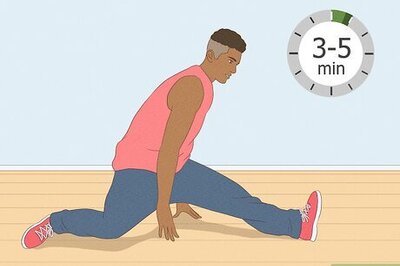




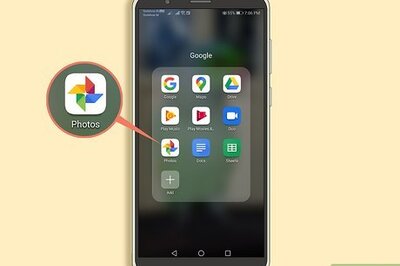
Comments
0 comment